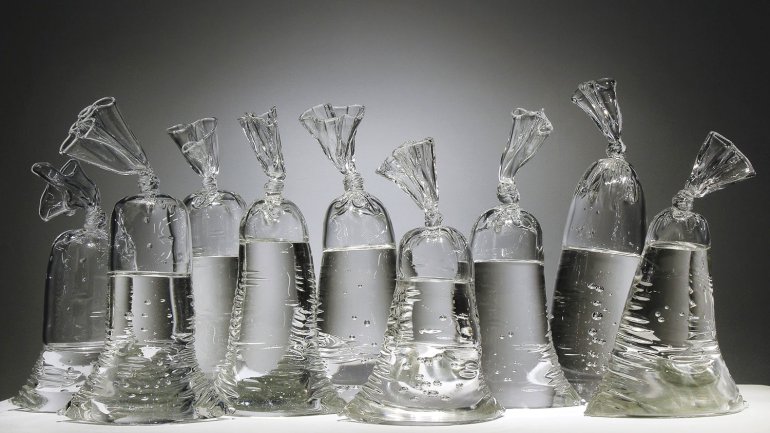Dylan Martinez
Dylan Martinez
Ask Dylan Martinez about his childhood in Minnesota and he’ll speak fondly of camping, fishing, playing sports, and helping his father, a mason, build structures for high-end homes. Ask the 31-year-old about art, though, and he’ll admit it’s a relatively new passion – and one closely connected to his love of scientific discovery.
In 2008, Martinez graduated from the University of Wisconsin-River Falls with a degree in science, because he’s always been interested in how things work. But one day in his junior year, he happened to wander past the glassblowing studio. “I was really struck by the process and all the equipment and the heat that it took to shape [glass],” he says. “So I tried it out, and it really resonated with me, both in the way that you move the material and how it seemed to react to a lot of the physical forces that I’d been studying in physics and chemistry and geology.” He’s been studying it ever since.
His practice has grown from exquisitely executed glassware and vases, which he mastered while apprenticing under Sam Stang of Augusta Glass Studio from 2010 to 2012, to sculpture and installation. The transition stems partly from his MFA studies at Ball State University – he graduated in July – and partly from his appetite for experimentation. Working with glass has become less about mastering decorative design than about exploring its properties from a scientific point of view: “What are the effects of trying not to have, necessarily, a direct end goal but kind of a more exploratory system of ‘This is the material, and this is what it can do’?”
Take, for example, his Water Bags, a recent series of sculptures that are both hollow and solid, complete with rising bubbles and creases so accurately folded that the forms could easily be mistaken for the real thing. The works combine delicate goblet-making techniques with methods that render the bag’s heavy, “super-solid” bases.
Or look at Inverted Logic (2017), an installation that juxtaposes camera lenses and photo enlargers against grids of black lines to explore perception. Cumulonimbus (2017), built from fluorescent tubes and a Tesla coil, is a representation of the dramatic weight of storm clouds.
In many ways, the glass studio is similar to the science labs that first intrigued Martinez. Each piece he creates evolves out of experimentation, requiring an observant eye to study what works, what doesn’t, and why. It’s a healthy practice for a budding artist keen on learning through problem solving. “As I was trying to figure out why I was so interested in glass and glassblowing,” he says, “I felt like it was, in many ways, a means of self-discovery.”
Glass Lab
Entry point: Although a lot of his work tackles complex subjects, Martinez isn’t a big fan of highly conceptual art, which he thinks can turn people away. “If you don’t understand art history or the foundations of art, it’s hard to grasp what someone’s talking about,” he says.
Give and take: Martinez loves teaching others the tricks he’s learned in the studio. The more people share – both as artists and as members of a global community – the more everyone grows, he says.
Sight lines: Martinez is red-green colorblind, which has inspired him to explore perception in his work. “I’ve always been curious: How is [color] different, and is it more beautiful than [what] I see? Or maybe I see it more beautifully than other people,” he muses. “We all see the same stuff, but we all see it slightly differently.”




